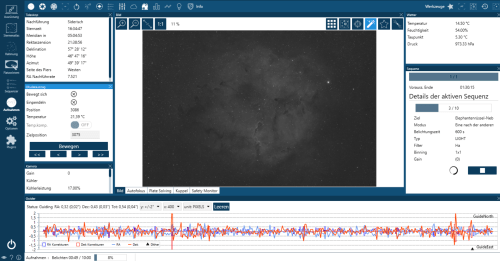William Optics RedCat 61 WFID
Review of William Optics RedCat 61 WFID | Review by Nils from Germany
Hallo my name is Nils and I’m an astrophotographer from Germany. I ordered this telescope after seeing it on the ATT in Essen in May 2023. I use it with a Player One Poseidon mono camera in APSC format (IMX 571). I’ve tested it in 3 nights so far. So I can give a first review.
Mechanical design William Optics RedCat 61 WFID

The telescope itself is a compact well machined package. The manual rotator is very stable and has a well made scale for precisely adjusting the camera angle. I connected my Poseidon M with filter wheel and OAG to the M48 thread with the rotator and it works fine.
The internal focuser is a game changer in astro-photography in my opinion. Camera tilt or weight issues are minimized, because the camera is not mounted directly to the focuser. Also you can connect an motorized focuser on it, which was more difficult with the older models, like the Red Cat 51.
I installed a ZWO EAF on the coarse focus knob. The assembly turned out to be tricky, because you first have to find the internal screw to remove the knob.
The focus knobs have a very large diameter. In my case the focus knobs collided with my mount saddle. So I had to put a Vixen plate between tube rings and Losmandy plate to get a gap to my mount saddle. The focus scale window is a nice feature, to check and mark your custom focus position. So far, I have not had any problems with incident light, dew or humidity.
The maximum distance between the tube rings is too small. The diameter for the dew cap is slightly larger than the inner clamp diameter, so you can‘t mount it there.


Optical performance
I tested my setup on the Elephant’s Trunk Nebula. Here is an 18 x 10min Ha-stack (3nm), I captured from my backyard under a Bortle 4 sky. I used N.I.N.A and an Eagle LE. I tried the low noise mode with gain 0 and cooled my camera down to -10°C.
As you can see, the stars are very small over the entire field. The field itself is illuminated homogeneously. I only processed the image with BlurX- and NoizeX terminator to sharpen the nebula and reduce noise and star size. I also checked the star size in the corners with the abberation tool in N.I.N.A. In the upper left corner the stars are slightly deformed. I will fix this by adjusting the tilt knobs on my Poseidon camera. A friend uses the same telescope with a full frame sensor and he has pinpoint stars in all corners.
When zooming in, the stars appear a bit blocky, because the pixel scale is not ideal. That’s why I dither and drizzle my images. I recommend the Red Cat 61 for pixel sizes of 3,8 microns or smaller. Larger pixels might be ok too, but will result in more blocky stars.
Summary of review William Optics RedCat 61 WFID
Plus points:
- compact telescope, ideal for traveling
- well made mechanics and surfaces
- internal focus design, less tilt and vignetting problems, no external movement
- focus motor can be mounted directly
- 46mm image circle for full frame, option to upgrade from small sensor to full frame
- tube rings with holes for cable passage and threads for mounting additional devices
- only 300mm focal length, wide field of view, perfect for large nebulae or star fields
- very good optical performance
- small round stars, homogeneous illumination over the entire field
Minus points:
- focus knobs are too large and may collide with the mount saddle
- the maximum distance between the tube rings is to small
Final thougths
A very nice little telescope, finally with a classic focuser. The mechanical design and the optical performance convinced me. The open focus scale could potentially be a problem, if dew or dirt gets in, but for now there are no problems. I give 5 stars out of 5 and recommend this telescope for use with small pixels like 3,8 microns.
A joke on the end. An integrated dew heater strip with output connector would be very nice. Maybe with the next generation of red cat.
Clear skys
Nils


